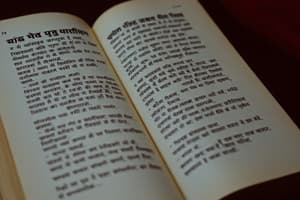Podcast
Questions and Answers
Which of the following is a primary language spoken in Bangladesh?
Which of the following is a primary language spoken in Bangladesh?
- Urdu
- Hindi
- Tamil
- Bengali (correct)
What is the writing system used for the Bengali language?
What is the writing system used for the Bengali language?
- Cyrillic script
- Bengali script (correct)
- Latin script
- Devanagari script
Who among the following is known as the national poet of Bangladesh?
Who among the following is known as the national poet of Bangladesh?
- Nizami Ganjavi
- Jibanananda Das
- Kazi Nazrul Islam (correct)
- Rabindranath Tagore
In Bengali grammar, what is the typical word order for sentences?
In Bengali grammar, what is the typical word order for sentences?
What was the significance of the Language Movement of 1952 in Bangladesh?
What was the significance of the Language Movement of 1952 in Bangladesh?
Study Notes
Language
- Bengali, also known as Bangla, is an Indo-Aryan language.
- It is the primary language spoken in Bangladesh and the Indian state of West Bengal.
- Over 230 million speakers, making it one of the most spoken languages in the world.
Script
- Written in the Bengali script, which is an abugida.
- The script consists of 11 vowels and 39 consonants.
- Features unique characters and diacritics for pronunciation.
Dialects
- Various regional dialects exist, including:
- Standard Bengali (the basis for formal writing and education)
- Dhakaiya (spoken in Dhaka)
- Chittagong dialect (spoken in Chittagong)
- Sylheti (spoken in Sylhet)
Literature
- Rich literary tradition with significant contributions in poetry, prose, and drama.
- Notable figures include:
- Rabindranath Tagore: First non-European Nobel laureate in Literature.
- Kazi Nazrul Islam: National poet of Bangladesh.
- Jibanananda Das: Influential modern poet.
Culture
- Integral to Bengali culture are festivals like:
- Pohela Boishakh: Bengali New Year.
- Durga Puja: Major Hindu festival.
- Ekushey Book Fair: Celebrating language and literature.
History
- The language has evolved over centuries, influenced by Sanskrit, Persian, Arabic, and English.
- The Language Movement of 1952 in Bangladesh (then East Pakistan) was pivotal for the recognition and promotion of Bengali.
Grammar
- Subject-Object-Verb (SOV) word order.
- Nouns and pronouns have gender distinctions.
- Rich system of verb conjugation based on tense, mood, and aspect.
Important Concepts
- "Bhasha Andolon" (Language Movement) emphasizes the importance of language in identity.
- Bengali is not only a means of communication but also a cultural symbol.
Influence
- Bengali influences extend to music, dance, and art.
- The fusion of various cultural elements has shaped contemporary Bengali identity.
Language
- Bengali, or Bangla, belongs to the Indo-Aryan language family.
- It is the official language of Bangladesh and prevalent in West Bengal, India.
- More than 230 million speakers rank Bengali among the world's most widely spoken languages.
Script
- The Bengali script is an abugida system.
- The script consists of 11 vowels and 39 consonants.
- Unique characters and diacritics aid in accurate pronunciation.
Dialects
- Standard Bengali serves as the foundation for formal writing and education.
- Dhakaiya is a dialect native to Dhaka, the capital of Bangladesh.
- Chittagong dialect is spoken in the southeastern region of Chittagong.
- Sylheti is commonly spoken in the Sylhet division of Bangladesh.
Literature
- Bengali boasts a rich literary heritage across poetry, prose, and drama.
- Rabindranath Tagore became the first non-European to win the Nobel Prize in Literature.
- Kazi Nazrul Islam is regarded as the national poet of Bangladesh.
- Jibanananda Das is recognized as a significant modern poet.
Culture
- Cultural events such as Pohela Boishakh mark the Bengali New Year.
- Durga Puja is a prominent Hindu festival celebrated in Bengali culture.
- Ekushey Book Fair highlights the importance of language and literature in society.
History
- Bengali evolved over centuries and has been shaped by influences from Sanskrit, Persian, Arabic, and English.
- The Language Movement of 1952 was crucial in advocating for the recognition and significance of Bengali in Bangladesh.
Grammar
- Bengali follows a Subject-Object-Verb (SOV) structure in sentences.
- Nouns and pronouns exhibit gender distinctions.
- The language features a complex system of verb conjugation based on tense, mood, and aspect.
Important Concepts
- "Bhasha Andolon" refers to the Language Movement, reinforcing the role of language in national identity.
- Bengali serves not only as a communication tool but also as a vital cultural symbol.
Influence
- Bengali culture influences music, dance, and visual arts.
- A blend of cultural elements contributes to the evolving contemporary Bengali identity.
Studying That Suits You
Use AI to generate personalized quizzes and flashcards to suit your learning preferences.
Description
Explore the fascinating aspects of the Bengali language, including its unique script, regional dialects, and rich literary traditions. This quiz covers significant historical figures in Bengali literature and the cultural importance of the language in Bangladesh and West Bengal.




